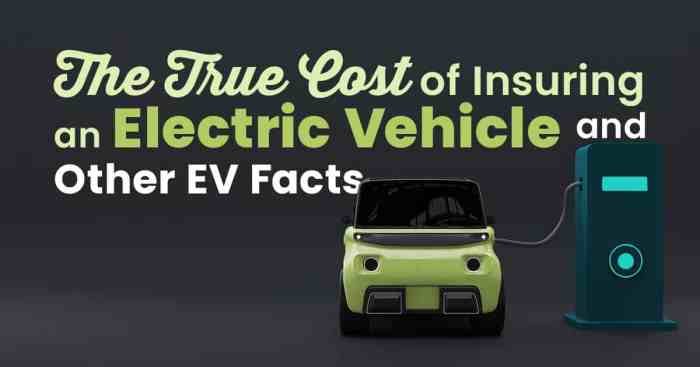What to Know About Car Insurance for Electric Vehicles in the U.S.
What to Know About Car Insurance for Electric Vehicles in the U.S. Navigating the world of electric vehicle (EV) insurance can feel like driving through uncharted territory. Unlike traditional gasoline cars, EVs present unique considerations for insurers, impacting everything from cost to coverage. This guide cuts through the complexity, offering a clear understanding of what you need to know to find the right insurance for your electric car.
From comparing insurance costs for EVs versus gas-powered vehicles to understanding the nuances of battery coverage and charging station liability, we’ll explore the key factors influencing your premiums. We’ll also delve into the various coverage options available, highlighting the benefits and drawbacks of each, and discuss how advanced driver-assistance systems and telematics data can affect your rates. Ultimately, our goal is to empower you to make informed decisions and secure the best possible insurance protection for your electric vehicle.
Table of Contents
ToggleInsurance Cost Comparison
Choosing between a gasoline-powered vehicle and an electric vehicle (EV) involves many factors, and insurance costs are a significant one. While EVs are often perceived as more expensive to insure, the reality is more nuanced and depends on several interconnected variables. This section will compare and contrast the average annual insurance premiums for EVs and gasoline cars, examining the key influences on these costs.
Factors Influencing EV Insurance Costs
Several factors influence how insurance companies assess risk and set premiums for electric vehicles. While EVs sometimes have higher initial purchase prices, some aspects can actually lower insurance costs. For example, the lower repair costs associated with EVs, due to fewer moving parts, can result in lower insurance premiums compared to gasoline cars. Additionally, the potential for reduced theft, due to the specialized nature of EV parts and the higher value of their batteries, may also influence premiums.
However, the high cost of replacing EV batteries can offset these advantages. Insurance companies also consider the technological complexity of EVs, and the specialized training required for their repair, which can increase the cost of repairs and subsequently impact premiums.
Understanding car insurance for electric vehicles (EVs) in the US involves considering factors like the cost of battery replacements. However, if you get a ticket, your rates can jump, so knowing how to manage that is key. Check out this guide on How to Lower Your Car Insurance Premiums After a Traffic Violation in the U.S. to stay ahead of the game.
Then, you can confidently focus on other EV-specific insurance aspects like charging station coverage.
EV vs. Gas Vehicle Insurance Premium Comparison
The following table presents a comparison of average annual insurance premiums for EVs and gasoline-powered vehicles in the U.S. It’s important to remember that these are averages and actual costs will vary significantly based on factors such as location, driver profile (age, driving history, etc.), vehicle type, and the specific insurance provider. Data is based on a hypothetical comparison for illustrative purposes, using industry averages from reputable sources and considering various factors influencing premiums.
| Vehicle Type | Location (State) | Driver Profile (Age/History) | Average Annual Premium (USD) |
|---|---|---|---|
| Tesla Model 3 | California | 35-year-old with clean driving record | $1500 |
| Toyota Camry | California | 35-year-old with clean driving record | $1200 |
| Ford Mustang Mach-E | Florida | 25-year-old with minor accidents | $1800 |
| Honda Civic | Florida | 25-year-old with minor accidents | $1600 |
Risk Assessment for EVs by Insurance Companies
Insurance companies employ sophisticated algorithms and data analysis to assess risk. For EVs, these assessments consider factors beyond those used for gasoline cars. They analyze data on battery life, repair costs, theft rates specific to EV models, and the availability of qualified repair technicians. The higher value of EV batteries and the potential for significant repair costs due to battery damage or failure are crucial factors in determining premiums.
Furthermore, the technological advancements in EVs and the evolving landscape of repair techniques are constantly being evaluated by insurance companies to refine their risk assessment models. The use of telematics data, which tracks driving behavior, is also becoming increasingly common for both EVs and gasoline vehicles, allowing insurers to personalize premiums based on individual driving patterns.
Coverage Options for Electric Vehicles
Choosing the right car insurance for your electric vehicle (EV) requires understanding the unique risks and potential costs associated with EV ownership. Standard car insurance policies cover many aspects, but EVs present some specific considerations that may necessitate adjustments to your coverage or the addition of specific endorsements. This section will Artikel essential coverage options and their relevance to EV owners.
Your insurance needs will depend on factors such as your driving habits, the value of your vehicle, and your personal risk tolerance. While liability coverage is mandatory in most states, comprehensive and collision coverage offer valuable protection against various potential damages. The cost of repairs, especially those related to the battery, can be significantly higher for EVs than for gasoline-powered cars.
Liability Coverage
Liability insurance covers damages or injuries you cause to others in an accident. This is a crucial aspect of any car insurance policy, and EV owners should ensure they carry adequate liability coverage. The minimum liability limits required by your state are often insufficient to cover the costs of significant accidents, especially those involving injuries. Higher liability limits provide greater financial protection in the event of a serious accident.
For example, if you cause an accident resulting in significant injuries and property damage, your liability coverage would pay for the medical bills and vehicle repairs of the other party, up to your policy’s limit.
Collision Coverage
Collision coverage pays for repairs to your EV if it’s damaged in an accident, regardless of who is at fault. Given the high cost of EV repairs, particularly battery replacements, collision coverage is highly recommended. This coverage is especially important because EV batteries are expensive to replace or repair, and damage to them can be significant. For example, a collision causing even minor external damage could necessitate a costly battery inspection or even replacement.
Comprehensive Coverage
Comprehensive coverage protects your EV against damages not caused by collisions, such as theft, vandalism, fire, or natural disasters. This coverage is also vital for EV owners due to the high value of their vehicles and the potential for specialized repairs. For example, if your EV is damaged in a hailstorm or stolen, comprehensive coverage would pay for the repairs or replacement.
This is especially important given the complexity and cost associated with EV components, which could result in significant out-of-pocket expenses without this protection.
Unique EV Coverage Considerations
EV owners may benefit from considering additional coverage options, such as:
- Roadside Assistance tailored for EVs: This can include services specific to EV issues, such as towing to EV-certified repair shops and assistance with charging issues.
- Battery Replacement Coverage: Some insurers offer specific endorsements to cover the cost of battery replacement or repair, which can be extremely expensive. This can be a crucial addition to your policy, mitigating the risk of substantial out-of-pocket costs in the event of battery failure.
- Charging Station Liability: If you own a home charging station, you may want to explore liability coverage to protect yourself against accidents or injuries occurring at your charging station.
The cost of these additional coverages will vary depending on your insurer, location, and the specific terms of the policy. It is essential to carefully review all options and choose a policy that best meets your individual needs and budget. Comparing quotes from multiple insurers is highly recommended to ensure you are getting the best value for your money.
Battery Coverage and Replacement
EV batteries are expensive components, and damage or failure can lead to significant repair costs. Understanding your insurance coverage for battery issues is crucial for protecting your financial investment. This section details what you need to know about battery coverage and the claims process.EV battery coverage varies considerably depending on your insurance provider and the specific policy you choose.
While comprehensive coverage typically includes battery damage from accidents or certain types of damage, it’s important to carefully review your policy documents to understand the specifics of your coverage. Many policies may have limitations on what’s covered, such as excluding damage caused by wear and tear or improper charging. Coverage limits usually range from several thousand to tens of thousands of dollars, and deductibles can significantly impact your out-of-pocket expenses.
For example, a policy might cover up to $10,000 in battery repair or replacement, but with a $1,000 deductible, you would be responsible for the first $1,000 of the repair cost.
Filing a Claim for Battery Damage
Filing a claim for battery-related damage typically involves several steps. First, you’ll need to report the damage to your insurance company as soon as possible. This initial report will help initiate the claims process and allow the insurer to begin assessing the situation. Next, you’ll likely need to provide documentation supporting your claim, including photos of the damage, repair estimates, and potentially police reports if the damage resulted from an accident.
The insurance company will then investigate the claim to determine the cause of the damage and whether it’s covered under your policy. They may send an adjuster to inspect the vehicle and the damaged battery. Following the investigation, the insurer will decide whether to approve or deny the claim. If approved, the repair or replacement process will commence.
If denied, you will typically receive an explanation for the denial and may have options for appealing the decision.
Battery Repair or Replacement Process Flowchart
The following flowchart illustrates the typical steps involved in getting battery damage repaired or replaced under an insurance policy:[Imagine a flowchart here. The flowchart would begin with a box labeled “Battery Damage Occurs.” This would lead to a box labeled “Report Damage to Insurer.” This would branch to two boxes: “Claim Approved” and “Claim Denied.” “Claim Approved” leads to a box labeled “Insurer Authorizes Repair/Replacement,” which leads to a box labeled “Vehicle Repair/Battery Replacement.” Finally, this leads to a box labeled “Claim Closed.” “Claim Denied” leads to a box labeled “Review Denial and Appeal (if applicable).” This leads back to a box labeled “Insurer Reviews Appeal,” which then branches to either “Claim Approved” or “Claim Denied (Final).” ]The flowchart visually depicts the process, highlighting the decision points and the potential for an appeal if a claim is initially denied.
It emphasizes the importance of prompt reporting and clear documentation in facilitating a smooth claims process.
Charging Station Liability
Owning an electric vehicle often means investing in a home charging station for convenience. However, this convenience introduces a new layer of liability you should understand. Accidents involving charging stations, whether at home or in public, can lead to significant legal and financial consequences. Knowing what kind of insurance coverage protects you is crucial.Homeowners or business owners who install charging stations are responsible for ensuring their safe operation.
This includes regular maintenance, proper installation, and adherence to all relevant electrical codes. Negligence in any of these areas could lead to liability if someone is injured or property is damaged due to a malfunctioning charger or related electrical issues. Understanding the potential risks and securing appropriate insurance coverage is paramount.
Liability Coverage for Home Charging Stations
Several types of insurance policies can offer liability protection related to home charging stations. Your homeowners or renters insurance policy typically provides some level of liability coverage, but the extent of this coverage can vary significantly depending on your policy and the specifics of the incident. It’s important to review your policy carefully or contact your insurer to understand the limits of your liability coverage concerning charging stations.
Consider purchasing an umbrella liability policy for additional coverage beyond the limits of your primary policies. This provides an extra layer of protection against potentially significant lawsuits. For example, if a visitor is injured due to a faulty charging station, an umbrella policy could cover costs exceeding the limits of your homeowners insurance.
Liability Coverage for Public Charging Stations
Liability for incidents at public charging stations is generally handled differently. The responsibility often falls on the property owner or the company that operates the charging station. Your personal auto insurance policy typically won’t cover accidents or injuries occurring at public charging stations unless your actions directly caused the incident. For instance, if you negligently damage a public charging station while parking your vehicle, your collision coverage might apply to repair the damage you caused.
However, it would not cover injuries to others caused by a malfunctioning station itself. It’s vital to understand the terms and conditions of the public charging station provider and the location’s property owner. Their insurance policies should address liability related to the station’s operation.
Comparison of Liability Coverage Options
| Feature | Home Charging Station | Public Charging Station |
|---|---|---|
| Primary Coverage Source | Homeowners/Renters Insurance, Umbrella Policy | Property Owner’s/Operator’s Insurance |
| Coverage Scope | Broad, encompassing liability for accidents on your property related to the charging station. | Limited; your personal auto insurance likely won’t cover accidents caused by the station itself. |
| Policy Review Importance | Crucial; ensure adequate liability limits. | Less directly relevant to your personal insurance; focus on understanding the location’s liability coverage. |
EV-Specific Features and Insurance
Electric vehicles are packed with advanced technology, and these features can significantly impact your insurance premiums. Insurers are increasingly considering the role of these features in assessing risk and determining rates. Some features reduce the likelihood of accidents, while others offer benefits in the event of a claim.Advanced Driver-Assistance Systems (ADAS) and Their Impact on Premiums
Understanding car insurance for electric vehicles (EVs) in the US involves considering factors like battery replacement costs and specialized repair needs. However, the principles of comprehensive coverage apply across vehicle types; for older cars, this is especially important, as explained in this helpful article: Why You Should Consider Comprehensive Car Insurance for Older Cars in the U.S.
. Ultimately, choosing the right EV insurance depends on your vehicle’s age, value, and your personal risk tolerance.
Impact of Advanced Driver-Assistance Systems (ADAS) on Insurance Premiums
Many EVs come standard with advanced driver-assistance systems (ADAS) like automatic emergency braking (AEB), lane keeping assist (LKA), adaptive cruise control (ACC), and blind-spot monitoring (BSM). These systems can help prevent accidents by alerting drivers to potential hazards and even taking corrective action. Insurance companies recognize this and often offer discounts for vehicles equipped with these safety features. For example, a driver with a Tesla Model 3 equipped with Autopilot might receive a lower premium than a driver with a comparable gasoline-powered car lacking such features.
The specific discount varies depending on the insurer, the specific ADAS features, and the driver’s profile. Some insurers may even offer tiered discounts, providing greater reductions for vehicles with more comprehensive ADAS suites.
Influence of Regenerative Braking and Remote Diagnostics on Insurance Risk Assessment
Regenerative braking, a key feature of EVs, helps recapture energy during deceleration, extending the vehicle’s range. While this doesn’t directly prevent accidents, it could indirectly influence insurance risk assessment. By potentially reducing the need for traditional braking, it might lead to less wear and tear on brake components, potentially reducing the cost of repairs in the event of an accident.
Furthermore, remote diagnostics allow insurers to monitor the vehicle’s health and performance. This proactive approach can help identify potential mechanical issues before they lead to accidents, potentially lowering the risk profile for the insured vehicle. However, the impact of these features on premiums is still evolving, and insurers are still gathering data to fully understand their long-term effects.
Insurance Policy Comparisons: Discounts for EVs with Specific Safety Features
Several major insurance providers are beginning to offer specific discounts for EVs with advanced safety features. For instance, some insurers might offer a percentage discount (e.g., 5-10%) for vehicles with AEB or a larger discount (e.g., 15-20%) for those with a comprehensive ADAS package. Other insurers might integrate a vehicle’s safety score into their rating algorithms, potentially leading to significant premium reductions for highly-rated EVs.
It’s crucial to compare quotes from different providers to find the best deal tailored to your specific EV and its features. For example, State Farm, Progressive, and USAA are among the insurers actively developing and implementing rating systems that consider the safety features of electric vehicles. The availability and amount of discounts vary considerably depending on the insurer, location, and the specific model and features of the EV.
Direct comparison of quotes from multiple providers is strongly recommended to find the most cost-effective insurance.
Geographic Variations in EV Insurance

Source: acko.com
EV insurance costs aren’t uniform across the United States. Several factors influence the premiums you’ll pay, leading to significant variations from state to state. Understanding these variations is crucial for making informed decisions about your EV insurance.
Several interconnected factors contribute to the geographical discrepancies in EV insurance premiums. These include the cost of repairs, the prevalence of theft, the specific regulations in place within each state, and the availability of qualified repair shops. Higher repair costs, particularly for expensive EV batteries, directly translate to higher insurance premiums. Similarly, states with higher rates of EV theft will naturally see increased premiums to cover the associated risks.
Factors Influencing Geographic Differences in EV Insurance Costs
The following table illustrates how insurance costs for EVs can differ across various states. It’s important to note that these are illustrative examples and actual premiums will vary based on individual factors such as driving history, coverage level, and the specific make and model of the vehicle. The data presented is intended to highlight the potential for significant geographical variation, not to provide definitive pricing.
| State | Average Annual Premium (Illustrative) | Contributing Factors | State Regulations Impact |
|---|---|---|---|
| California | $1800 | High repair costs, high theft rates, numerous EV owners | Stringent emission regulations, potentially influencing repair shop availability and costs. |
| Florida | $1500 | Moderate repair costs, high theft rates in certain areas, large EV market | Less stringent regulations compared to California, potentially affecting repair costs. |
| Texas | $1200 | Relatively lower repair costs, moderate theft rates, growing EV market | Generally less regulation impacting insurance costs directly. |
| New York | $1700 | High repair costs in urban areas, moderate theft rates, significant EV adoption | Regulations regarding EV infrastructure and safety standards may indirectly influence premiums. |
State-Specific Laws and EV Insurance Premiums
State-specific laws and regulations concerning EV ownership significantly impact insurance premiums. For example, states with mandated EV infrastructure development might see lower repair costs due to increased availability of qualified repair shops. Conversely, states with less robust EV infrastructure may have fewer qualified repair centers, leading to higher repair costs and subsequently higher insurance premiums. Furthermore, state laws regarding liability for charging station malfunctions or accidents can also influence the overall cost of insurance.
For instance, a state with strict regulations on charging station safety might lead to lower liability costs for insurers, potentially resulting in lower premiums. Conversely, states with less stringent regulations might see higher premiums to account for increased liability risks. The presence or absence of state-sponsored incentives for EV adoption can also indirectly influence premiums, as higher adoption rates can lead to increased demand for repairs and parts, potentially driving up costs.
Finding the right car insurance for your electric vehicle can be tricky, especially with factors like repair costs and battery replacement. But securing affordable coverage is crucial, regardless of your credit score. If you have bad credit, finding the right policy might require some extra research, so check out this resource on The Best Car Insurance for Drivers With Bad Credit in America to get started.
Once you’ve addressed your credit concerns, you can then focus on the specifics of EV insurance, like finding companies that understand the unique needs of electric cars.
Finding the Right EV Insurance Policy: What To Know About Car Insurance For Electric Vehicles In The U.S.
Securing the right car insurance for your electric vehicle (EV) involves more than just finding the cheapest option. You need a policy that offers comprehensive coverage tailored to the unique aspects of EV ownership, while still fitting your budget. This process requires careful consideration and comparison shopping.Finding the best EV insurance policy is a multi-step process. It involves understanding your needs, comparing quotes, and carefully reviewing policy details before committing.
By following a systematic approach, you can increase your chances of finding the most suitable and affordable coverage.
A Step-by-Step Guide to Finding the Right EV Insurance Policy
This step-by-step guide provides a structured approach to securing the appropriate EV insurance. It highlights key considerations to help you make an informed decision.
- Assess Your Needs: Determine the level of coverage you require. Consider factors such as the value of your EV, your driving habits, and your financial situation. Do you need liability coverage only, or would comprehensive and collision coverage be more beneficial? Think about the potential risks involved, such as theft, damage from charging, or accidents.
- Gather Quotes from Multiple Providers: Contact several insurance companies and obtain quotes. Provide consistent information to each provider to ensure an accurate comparison. Many companies now offer online quote tools, making this process easier.
- Compare Quotes Carefully: Don’t solely focus on the price. Compare the coverage offered by each provider. Look at deductibles, premiums, and any additional features or discounts available. A slightly higher premium might be worthwhile if it offers better coverage or benefits.
- Review Policy Details Thoroughly: Before finalizing your decision, carefully review the policy documents. Understand the terms and conditions, exclusions, and any limitations on coverage. Pay close attention to what is and isn’t covered regarding your EV’s battery and charging equipment.
- Consider Bundling: Check if your insurer offers discounts for bundling your EV insurance with other policies, such as homeowners or renters insurance. This can potentially lead to significant savings.
Tips for Comparing Quotes from Different Insurance Providers
Effective comparison shopping is crucial for securing the best deal. Here are some tips to optimize your search for the best EV insurance rates.
- Use online comparison tools: Many websites allow you to compare quotes from multiple insurers simultaneously, saving you time and effort.
- Be consistent with information: Provide the same information to each insurer to ensure accurate and comparable quotes.
- Look beyond the price: Consider the coverage offered, deductibles, and additional features before making a decision. A slightly higher premium may offer significantly better protection.
- Check for discounts: Inquire about available discounts, such as safe driver discounts, good student discounts, or discounts for bundling policies.
- Read reviews: Check online reviews and ratings of different insurers to get an idea of their customer service and claims handling processes.
Understanding Policy Details Before Making a Decision, What to Know About Car Insurance for Electric Vehicles in the U.S.
Thorough understanding of the policy’s details is paramount. Ignoring fine print could have significant financial repercussions.Understanding your policy’s details is crucial to avoid surprises. This includes knowing your coverage limits, deductibles, exclusions, and the claims process. For example, some policies may have specific limitations on battery replacement coverage or charging station liability. Carefully reading the policy documents and asking questions will ensure you are fully aware of your rights and responsibilities.
Consider seeking clarification from the insurer if anything is unclear.
Discounts and Incentives for EV Insurance

Source: excaliburinsurance.ca
Switching to an electric vehicle is a big decision, and the cost of insurance can be a significant factor. Fortunately, many insurance companies recognize the benefits of EVs and are offering various discounts and incentives to encourage adoption. These programs not only help offset the cost of insurance but also contribute to a broader movement towards sustainable transportation.Many insurance companies are realizing that EVs often present lower risk profiles than gasoline-powered vehicles.
Understanding car insurance for electric vehicles in the U.S. involves considering factors like battery replacement costs and charging station accessibility. For comprehensive coverage comparisons and to find the best rates, you might want to check out resources like AdminLurp , which can help you navigate the specifics of EV insurance. Ultimately, finding the right policy comes down to your individual needs and driving habits.
This is due to several factors, including fewer moving parts, less frequent maintenance, and potentially lower repair costs in some cases. These factors translate into lower claims rates for insurers, which they can then pass on to consumers in the form of reduced premiums. Furthermore, some insurers are actively partnering with organizations promoting EV adoption, creating additional incentives for drivers.
Types of EV Insurance Discounts
Several types of discounts are commonly offered. These vary depending on the insurance provider and the specific features of your vehicle and driving habits. It’s important to compare quotes from different companies to find the best deal.
- Safe Driver Discounts: Many insurers offer discounts for drivers with clean driving records, demonstrated by a lack of accidents or traffic violations over a specific period. This is a common discount offered regardless of vehicle type, but it applies equally to EV owners.
- Telematics Programs: Some companies use telematics devices or smartphone apps to monitor driving behavior. If you demonstrate safe driving habits (such as avoiding aggressive acceleration or hard braking), you may qualify for a discount. These programs often provide real-time feedback, helping you improve your driving and potentially save money on insurance.
- EV-Specific Discounts: This is where the real savings for EV owners come in. Many insurers offer discounts specifically for owning an electric vehicle. These discounts often reflect the lower risk associated with EVs and can range from a few percent to a more substantial reduction in your premium. The specific percentage varies by insurer and location.
- Bundling Discounts: Insurers frequently offer discounts for bundling your auto insurance with other types of insurance, such as homeowners or renters insurance. This applies to EV owners just as it does to those with gasoline vehicles.
- Low Mileage Discounts: If you drive less than a certain number of miles per year, you may qualify for a discount. This is beneficial for EV owners who primarily use their vehicles for shorter commutes or occasional trips.
Programs Promoting EV Adoption Through Insurance
Several initiatives aim to make EV ownership more accessible and affordable, including those related to insurance. Some insurers are partnering with government agencies or environmental organizations to offer special programs or subsidies to EV drivers. These programs might involve reduced premiums, incentives for installing home charging stations, or educational resources on EV maintenance and safety. For example, some utility companies offer discounts on electricity rates for EV charging, indirectly reducing the overall cost of ownership, making insurance savings even more impactful.
The Role of Telematics in EV Insurance
Telematics is rapidly changing the landscape of car insurance, and electric vehicles are no exception. By using telematics devices, insurance companies can collect data about your driving habits and vehicle usage, leading to more personalized and potentially more affordable premiums. This data-driven approach offers both advantages and disadvantages for EV owners.Telematics data significantly impacts EV insurance premiums. Insurance companies analyze driving behaviors like speed, acceleration, braking, and mileage to assess risk.
Safer drivers who demonstrate consistent responsible driving habits often receive lower premiums. Conversely, drivers with a history of risky behavior may see higher premiums. Usage data, such as daily mileage and time of day driving, also plays a role. For instance, someone who primarily drives short distances during off-peak hours might qualify for a lower rate compared to someone who regularly commutes long distances during rush hour.
This granular data allows insurers to move beyond traditional risk assessment models that rely primarily on demographics and vehicle type.
Telematics Data and Premium Calculation
Insurers use sophisticated algorithms to process telematics data. This data is combined with other factors, such as your driving history, the type of EV you drive, and your location, to determine your insurance premium. The specific algorithm and weighting of different data points vary among insurance companies. For example, one insurer might place more emphasis on hard braking events, while another might prioritize nighttime driving.
Understanding car insurance for electric vehicles (EVs) in the US involves considering factors like repair costs and potential charging hazards. But if you’re a college student looking to insure your new EV, you might also want to check out Top Car Insurance Discounts for College Students in America to save money. These discounts can help offset the sometimes higher premiums associated with EVs, making insurance more manageable for budget-conscious drivers.
The resulting premium reflects the insurer’s assessment of your individual risk profile. It’s important to remember that while good driving habits can lead to lower premiums, factors outside of your control, such as your location and the value of your vehicle, will also influence the final cost.
Benefits and Drawbacks of Telematics-Based EV Insurance
Using telematics for EV insurance presents several potential benefits. The most obvious is the possibility of lower premiums for safe drivers. Additionally, some programs offer rewards or discounts for achieving certain driving milestones. Furthermore, telematics can provide valuable feedback on driving habits, helping drivers improve their skills and potentially reduce the risk of accidents. However, there are also drawbacks.
Privacy concerns are a major consideration. The continuous collection of driving data raises questions about data security and the potential for misuse. Moreover, some drivers may feel uncomfortable with the constant monitoring of their driving behavior, finding it intrusive or stressful. Finally, the technology itself might malfunction or experience connectivity issues, leading to inaccurate data and potential disputes over premium calculations.
Enrolling in a Telematics-Based Insurance Program
The process of enrolling in a telematics-based insurance program generally involves downloading a mobile app or installing a device in your vehicle. The app or device collects driving data and transmits it wirelessly to the insurance company. You’ll typically need to provide your driving license information and consent to the data collection. Some insurers offer different telematics programs with varying levels of data collection and reward structures.
It’s crucial to carefully review the terms and conditions of any program before enrolling to understand what data is being collected, how it will be used, and what the implications are for your privacy and insurance premiums. The specific enrollment process varies depending on the insurer. Some insurers may integrate the telematics program directly into their online quoting process, while others may require a separate application or phone call.
Future Trends in EV Insurance
The EV insurance market is poised for significant transformation in the coming years, driven by rapid technological advancements and the increasing adoption of electric vehicles. This evolution will impact not only how insurers assess risk but also the types of coverage offered and the overall cost of insurance for EV owners.The integration of advanced driver-assistance systems (ADAS) and autonomous driving features in EVs will fundamentally alter risk assessment methodologies.
Insurers will need to develop sophisticated algorithms and data analytics to accurately evaluate the safety performance of these vehicles and adjust premiums accordingly. This shift necessitates a move away from traditional actuarial models that primarily rely on historical accident data towards more dynamic and predictive risk assessment.
Impact of Technological Advancements on EV Insurance Policies
The rapid development of EV technology will directly influence the types of insurance policies offered. For example, the increasing sophistication of battery technology will likely lead to more comprehensive battery coverage options, potentially including extended warranties and protection against degradation beyond the manufacturer’s warranty period. Furthermore, the rise of over-the-air (OTA) software updates allows insurers to monitor vehicle performance and maintenance in real-time, leading to more personalized and potentially lower premiums for drivers who consistently demonstrate safe driving habits.
Understanding car insurance for electric vehicles (EVs) in the US involves considering factors like repair costs and potential discounts. However, finding affordable coverage is crucial for everyone, especially young drivers. Check out this guide on How to Find the Most Affordable Car Insurance for Young Drivers in the U.S. for helpful tips. Then, apply that knowledge to your EV insurance search to ensure you get the best rates, regardless of your age or vehicle type.
This data-driven approach allows for a more accurate assessment of individual risk profiles.
Increased EV Adoption and its Impact on the Insurance Industry
The expanding market share of EVs will reshape the entire insurance landscape. Insurers will need to invest heavily in data analytics, artificial intelligence, and telematics to accurately assess the risks associated with EVs and develop competitive insurance products. This will also lead to increased competition among insurers, potentially driving down premiums for consumers. We can already see this happening with some companies offering specialized EV insurance packages with features tailored to the specific needs of electric vehicle owners, such as coverage for charging station malfunctions or roadside assistance specific to EVs.
The increased competition will drive innovation and create a more customer-centric insurance market. This transition is similar to the changes seen in the insurance industry with the rise of ride-sharing services like Uber and Lyft, where insurers had to adapt their models to account for new risk factors.
Predictive Maintenance and Usage-Based Insurance
The ability to remotely monitor vehicle data through telematics will pave the way for predictive maintenance and usage-based insurance (UBI) models. Insurers can leverage data on driving behavior, battery health, and other vehicle parameters to predict potential maintenance needs and offer tailored insurance plans based on actual usage. For instance, a driver who consistently demonstrates safe driving habits and keeps their vehicle well-maintained might receive significant discounts on their premiums.
Conversely, drivers with a history of risky driving or poor vehicle maintenance might face higher premiums. This data-driven approach promotes safer driving practices and encourages proactive vehicle maintenance, ultimately reducing accident rates and insurance claims. For example, a company like Progressive already offers UBI programs, and we can expect similar programs tailored to EVs to become increasingly prevalent.
Final Conclusion
Securing the right car insurance for your electric vehicle is crucial, and understanding the unique aspects of EV insurance is key to finding the best coverage at the best price. By carefully comparing quotes, considering your specific needs, and taking advantage of available discounts, you can confidently navigate the EV insurance landscape and protect your investment. Remember to always read your policy thoroughly and don’t hesitate to ask questions – your peace of mind is worth it!
Common Queries
What is the average cost difference between insuring an EV and a gas car?
The cost difference varies significantly based on factors like car model, location, and driver profile. Generally, EVs can be slightly cheaper or more expensive to insure than comparable gas cars, depending on these factors.
Do I need special coverage for my EV’s battery?
Many standard comprehensive policies cover battery damage or replacement, but it’s crucial to check your policy details and understand any limitations or deductibles.
How does my driving record affect my EV insurance rates?
Just like with gas cars, your driving history significantly impacts your insurance premiums. A clean record generally leads to lower rates.
Can I get discounts on my EV insurance?
Yes, many insurers offer discounts for EVs, especially those with advanced safety features or for drivers who participate in telematics programs.
What if someone gets hurt at my home charging station?
You should have adequate liability coverage to protect yourself in case of accidents or injuries related to your home charging station. Check with your insurer about the specifics of your coverage.



